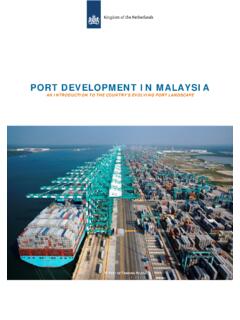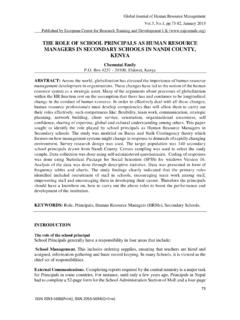Transcription of 2016 Kenyan Healthcare Sector Report - RVO.nl
1 Kenyan Healthcare SectorOpportunities for the Dutch Life Sciences & Health Sector Commissioned by the ministry of Foreign Affairs Study commissioned by the Embassy of the Kingdom of the Netherlands in Nairobi Kenyan Healthcare Sector Opportunities for the Dutch Life Sciences & Health Sector September 2016 Kenyan Healthcare Sector : MARKET STUDY Report | 2 Kenyan Healthcare Sector : MARKET STUDY Report | 3 Kenyan Healthcare Sector Market Study Report : Opportunities for the Dutch Life Sciences & Health Sector Study commissioned by the Embassy of the Kingdom of the Netherlands in Nairobi September, 2016 Kenyan Healthcare Sector : MARKET STUDY Report | 4 Top 10 Reasons Why kenya is interesting for the Dutch Health Sector 1. The Dutch have a good Reputation: The Netherlands has a good reputation in kenya and is the only country in Europe with which kenya has a positive trade balance (mainly due to the flower business). See page 10. 2. Long-term Dutch support in improving Kenyan Healthcare Sector : On top of this, kenya has been one of the few African countries which for many years received (financial) support from the Netherlands for strengthening the Healthcare Sector .
2 The Netherlands has always been committed and involved! See page 81. 3. Strong Dutch presence in Kenyan Healthcare : Partly as a result of the latter, several Dutch organisations have already build an impressive track record and the Netherlands already invested a lot in health in kenya . See text boxes on pages 24, 41, 42, 46, 47, 50, 81. 4. Renewed Dutch focus on kenya : Recently the Dutch Topsector LSH has marked East Africa ( kenya being considered as central hub) as one of the three focus areas (besides US and China). Meaning continuous support for Dutch health organisations doing or willing to do business in kenya . See page 10. 5. Decentralisation of Kenyan Healthcare Sector : In 2013 kenya reformed the Healthcare system and Sector with the so-called devolution , meaning that the 47 counties gained a relatively high degree of autonomy. See pages 22, 25, 26, 27, 55, 57. 6. kenya is the Healthcare Frontrunner in East Africa: kenya is widely regarded as th business hub in East Africa and eager to adopt innovations while functioning as a Healthcare testbed for the region.
3 See pages 46, 49, 50. 7. Huge Potential for Growth: Although being a frontrunner in the region, only 25% of Kenyans are covered by a health insurance scheme. Innovative financing solutions are needed and access to Healthcare needs to be secured. See pages 28, 41, 61. 8. Priority on Capacity building: Moreover, due to the low Healthcare coverage both the public and private Sector are expanding their efforts to strengthen the health infrastructure and overcome the shortage of health workers. See pages 23, 32, 34, 41, 47, 51, 59. 9. Fast growing private Sector : Private Sector is responding to an increasing demand for quality Healthcare living up to Western standards and budgets for high-end branded equipment to attract customers. There are many investments and influences coming from India. See pages 34, 38, 58, 59. 10. High-volume low-cost concepts: Due to the above-average Indian presence in kenya many low-cost high-volume concepts are introduced and operable in kenya .
4 This principle provides opportunities for comparable Dutch smart solutions. See page 60. Kenyan Healthcare Sector : MARKET STUDY Report | 5 Executive Summary About this Report This Report was commissioned by the Embassy of the Kingdom of the Netherlands (EKN) in Nairobi, kenya . It is produced by kenya Healthcare Federation (KHF) and Task Force Health Care (TFHC) and sets out a high level analysis of the Healthcare Sector in kenya , business opportunities for organisations active within the Dutch Life Sciences & Health Sector , and recommendations for the EKN on how to increase the involvement of the Netherlands in the Kenyan Healthcare Sector . Methodology This Report is based on a desk research and a fact-finding visit to kenya to gain insights from key stakeholders in the Kenyan Healthcare Sector and position the Dutch Life Sciences & Health Sector as a potential valuable partner. Annex 1 provides an overview of the contacts during this week. A Brief Introduction to kenya kenya is one of the 6 countries of the East Africa Community (EAC) and is widely regarded as the business hub for East Africa.
5 The economy is growing, the workforce is strong and capable, the population young and educated, and English being one of the national languages (besides Kiswahili). Together with the economy, kenya s middle class ( of total population) and the demand for quality Healthcare is on the rise. kenya has an estimated population of 46 million with an average population growth of 1 million per year, with a median age of 19 years and a high (although declining) fertility rate of children per woman. The country is experiencing a population flow from the rural areas to the city centres and currently about 25% of all Kenyans live in an urban setting. kenya s burden of disease has historically been mostly focused on communicable diseases. However, recent research shows a large and fast increase in the prevalence of non-communicable diseases such as cancers and cardiovascular diseases. This is mainly attributed to life style changes of Kenyans. In 2010, kenya adopted a new constitution which created a devolved government which established 47 counties which are governed by their own governments and have a relatively high degree of autonomy when it comes to budget allocations including for Healthcare .
6 kenya s Healthcare System The Kenyan Healthcare system can be split into three subsystems, being the Public Sector , Commercial Private Sector , and Faith Based Organisations (FBOs). The Public Sector is the largest in terms of the number of Healthcare facilities, followed by the Commercial Private Sector and the FBOs. There is a large disparity among these health facilities, especially in rural areas. The Total Health Expenditure (THE) has increased over the years by about 33% in a 2 year timeframe to KES 234 billion or USD 2,743 million in 2012/13. Health financing is mixed and receives funds from taxation, the National Health Insurance Fund (NHIF), private health insurances, employer schemes, Community Based Health Financing (CBHF), user fees (out of pocket expenses), development partners and Non-Governmental Organisations (NGOs). The government spending on Healthcare is approximately 6% of GDP which is low compared to other countries in the region. Approximately 25% of the Kenyans are covered by a public, private or Kenyan Healthcare Sector : MARKET STUDY Report | 6 community-based health insurance scheme.
7 The amount of Out Of Pocket (OOP) spending remains high, leading a lot of people into poverty and posing a barrier to access Healthcare . Especially at the base of the pyramid, people do not save or prepay for Healthcare or are not able to do so. In 2013, the public health services (primary and secondary level) moved from the national government and Ministry of Health (MOH) to the county governments. Since then, the MOH is limited to providing support and technical guidance to the counties and is responsible for regulating the health Sector and the counties for providing the health services. The MOH is guided by the kenya Health Sector Strategic Plan (KHSSP) 2013-2017 which is prepared for every four-year election cycle. In August 2017, kenya has its national and county election after which the 5 year period will lend a new wave of Public Private Partnerships in the health Sector as the public Sector acknowledges that they cannot improve the health system without partnering with the private and FBO Sector .
8 Human Resources for Health (HRH) is still managed at national level. kenya has a high health worker shortage, mostly affecting the rural areas. Most health workers are employed in the private Sector , in which the competition for doctors drives the costs of Healthcare . Challenges are improving the capacity of training, efficiency of health workers, and reducing the so-called brain-drain where trained health workers look for greener pastures in the private Sector and abroad. Business Opportunities The Kenyan Healthcare Sector is experiencing exciting times. The middle class in kenya has been growing, together with the economy, increasing the demand for quality accessible health services. The private Sector has been vibrant with increased investments. At the same time, million Kenyans lack any form of basic insurance and are treated in ill-equipped and poorly staffed facilities. kenya s health Sector faces enormous deficiencies in coverage and infrastructure.
9 This study identified business opportunities for the Dutch Life Sciences & Health Sector in the following areas: Medical Devices In the public, private and FBO Sector , there is a demand for quality, affordable medical devices. Centralized purchasing and procurement are often used to obtain economies of scale. Especially in the private Sector , there is a rising demand for western standard therapeutic and diagnostic equipment. There is also a demand for supply chain solutions involving knowledge and technology to effectively distribute pharmaceuticals and medical supplies. The recent enactment of the Special Economic Zones Act (2015-SEZA) presents an opportunity to invest in manufacturing plants for medical supplies to the region. eHealth Health and ICT are slowly becoming more interconnected in kenya . kenya has proven to be a frontrunner in innovative ICT solutions in general and also in the health Sector . It is the only African country with a comprehensive eHealth strategy and the only country in the world with a multi-billion USD turnover of mobile money (mPesa) payments that is more and more being linked to paying for Healthcare services.
10 Telemedicine, Health Management Information Systems, Hospital Information Systems, eLearning and serious gaming are gaining increased attention. Training and Education The shortage of health workers poses great opportunities for solutions contributing to effective capacity building. Curriculum development, training content, problem-based learning and eLearning are examples of much needed expertise to strengthen human resources for health. Next, hospital management skills is increasingly viewed as a separate discipline needed to be invested in. Kenyan Healthcare Sector : MARKET STUDY Report | 7 Hospital Build Both the public and private Sector are investing in the renewal, expansion or development of new hospitals, clinics and reaching out to rural areas (with additional mobile solutions). Expertise on hospital build brings knowledge and leverage targeting investors and donors. Health Financing Although kenya is a frontrunner in the region in terms of economic and technical developments, the country still only has a prepaid Healthcare coverage of about 25%.










